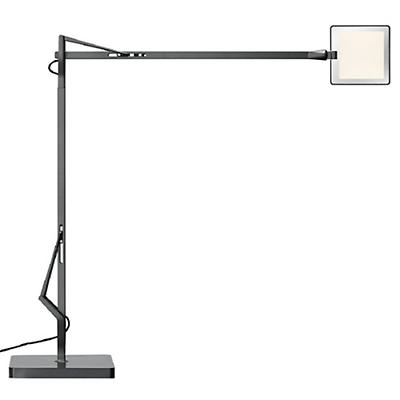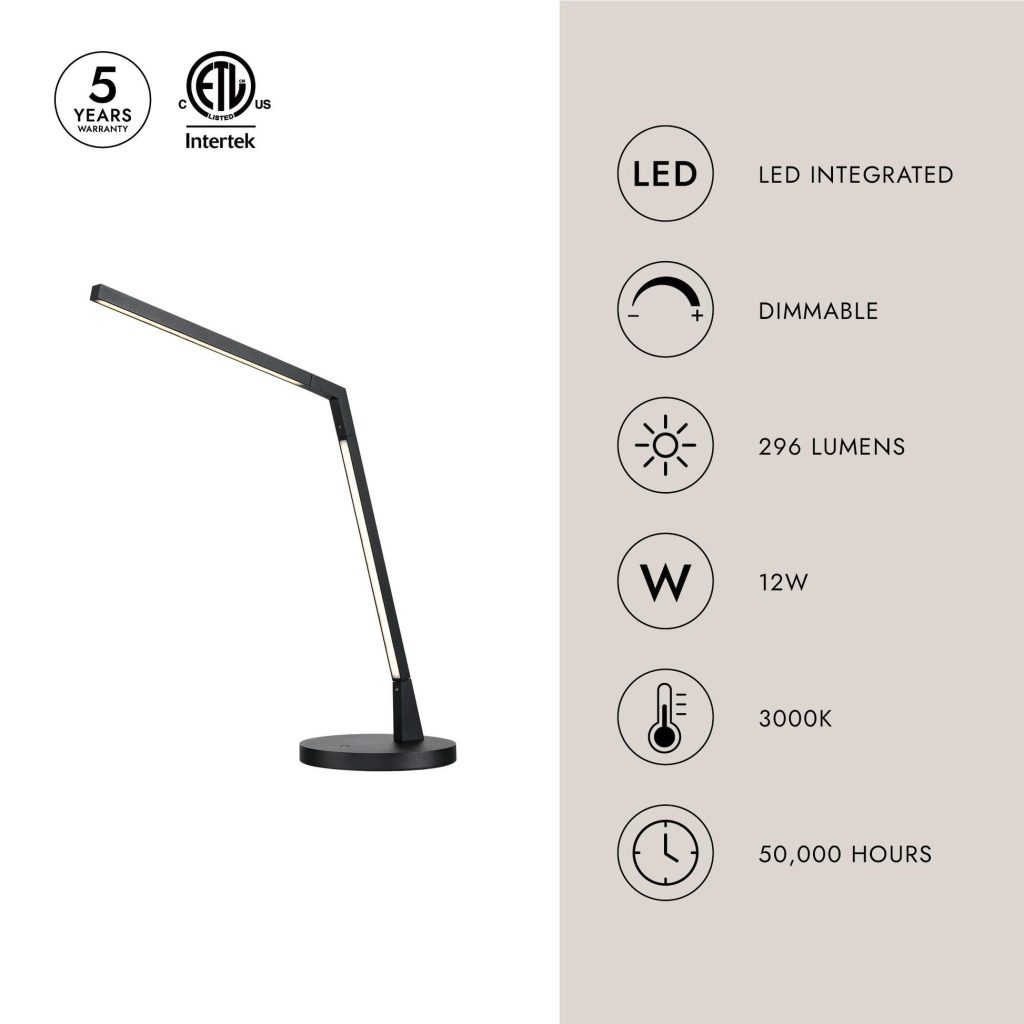Are you struggling to find the perfect desk lamp that gives you just the right amount of light? Knowing how many lumens your desk lamp provides can make all the difference in creating a comfortable and productive workspace.
Too little light strains your eyes, while too much can cause glare and headaches. You’ll discover exactly what lumens mean and how to choose the ideal brightness for your needs. By the end, you’ll feel confident picking a desk lamp that brightens your work without any guesswork.
Keep reading to light up your space the right way!

Credit: www.amazon.com
Lumens And Brightness
Understanding lumens helps you choose the right desk lamp brightness. Brightness affects how well you can read, write, or work at your desk. Lumens indicate the actual light output of a lamp. This makes lumens a better measure than wattage for brightness.
What Lumens Measure
Lumens measure the total amount of visible light a lamp emits. It tells how bright the light appears to the human eye. The higher the lumens, the brighter the light. For example, a desk lamp with 450 lumens is brighter than one with 300 lumens. Lumens focus on light output, not energy use.
Lumens Vs Watts
Watts measure energy consumption, not brightness. A lamp with higher watts uses more electricity. But it may not always be brighter. LED lamps use fewer watts but produce more lumens. Traditional bulbs use more watts for the same brightness. Check lumens to compare brightness, not watts.
Ideal Lumens For Desk Lamps
Finding the ideal lumens for your desk lamp can transform how you work or relax at your desk. The right brightness not only reduces eye strain but also boosts your focus and productivity. Knowing the right lumen level for different tasks helps you choose the perfect lamp without guesswork.
Low Light Tasks
For activities like checking your phone, casual browsing, or ambient lighting, you don’t need a very bright lamp. A desk lamp with around 200 to 400 lumens is enough to gently illuminate your space without overwhelming your eyes. This level keeps your environment cozy and prevents harsh glare during downtime.
Reading And Writing
If you often read books or write notes at your desk, aim for a lamp with about 450 to 800 lumens. This brightness helps you see text clearly without squinting or leaning too close. It also prevents eye fatigue during longer study or work sessions, making your lamp a reliable companion for focused tasks.
Detailed Work
Tasks like drawing, crafting, or working with small parts require strong, clear light. Choose a desk lamp that delivers between 800 and 1,200 lumens to highlight fine details and reduce shadows. Have you noticed how much easier it is to work when every little detail is visible? That’s the power of the right lumen level at work.
Types Of Desk Lamps
Choosing the right desk lamp can make a huge difference in how well you see and how comfortable you feel while working or reading. Different types of desk lamps offer various brightness levels, energy efficiency, and color temperatures. Understanding these types helps you pick a lamp that suits your needs and lighting preferences.
Led Lamps
LED lamps are popular for their energy efficiency and long lifespan. They provide bright, clear light that can be adjusted in many models to reduce eye strain during extended use. If you want a lamp that saves power and stays cool to the touch, LED is a smart choice.
I once switched to an LED desk lamp after struggling with headaches from poor lighting. The difference was immediate—my workspace felt brighter but not harsh, and my eyes felt less tired after long hours.
Fluorescent Lamps
Fluorescent desk lamps offer good brightness and use less energy than incandescent bulbs, but they can flicker and sometimes produce a cooler, bluish light. This might not be ideal if you want a warmer, more natural light for reading or relaxing.
Consider whether you are sensitive to flickering or if you need a lamp mainly for focused tasks. Fluorescent lamps are often more affordable but may require replacing tubes more frequently than LEDs.
Incandescent Lamps
Incandescent lamps deliver warm, soft light that many find comforting. However, they use more electricity and have shorter lifespans compared to LED and fluorescent options.
If you prefer a cozy atmosphere and don’t mind the higher energy use, an incandescent desk lamp might fit your style. Just ask yourself if you want to balance ambiance with efficiency.

Credit: www.lumens.com
Choosing The Right Brightness
Choosing the right brightness for a desk lamp is crucial. It affects productivity and eye health. Too bright, and it can cause glare. Too dim, and it strains the eyes. Finding the right balance ensures comfort and efficiency.
Room Size And Lighting
Consider the size of your room. A small room needs fewer lumens. Larger rooms need more. A lamp with 450 lumens works for a small desk. For a bigger space, aim for 800 lumens or more. Check existing lighting in the room. Natural light can reduce the need for high-lumen lamps.
Adjustable Brightness Options
Adjustable lamps offer flexibility. They allow changing brightness levels. This suits different tasks and times of the day. Reading requires more light. Computer work might need less. A lamp with dimming features can adapt easily. It provides optimal light based on activity and time.
Eye Comfort Considerations
Eye comfort is essential for long work hours. Bright lights can cause headaches. Soft, even lighting reduces strain. Lamps with diffusers can help. They spread light evenly across the workspace. Choose a lamp with a color temperature of 3000K to 5000K. This range mimics natural light and is gentle on the eyes.
Energy Efficiency And Lifespan
Understanding the energy efficiency and lifespan of a desk lamp is essential for making a smart purchase. You want a lamp that not only provides enough brightness but also saves electricity and lasts a long time. This keeps your energy bills low and reduces the hassle of frequent replacements.
Lumens Per Watt
Lumens per watt (lm/W) measures how much light a lamp produces for each watt of electricity it uses. A higher lm/W means better energy efficiency. For example, LED desk lamps often offer around 80-100 lumens per watt, while traditional incandescent bulbs may only provide 10-17 lumens per watt.
If you want to reduce your electricity costs, choosing a lamp with a high lumens-per-watt rating is key. It’s not just about brightness; it’s about how efficiently that brightness is produced. Have you checked the lm/W rating before buying your current desk lamp?
Lamp Durability
The lifespan of a desk lamp depends largely on the type of bulb it uses. LEDs can last 15,000 to 50,000 hours, which means they often outlive the desk lamp itself. In contrast, incandescent bulbs usually last only around 1,000 hours.
Durability also includes how well the lamp is built. Look for sturdy materials and a solid design to avoid frequent repairs or replacements. A well-made lamp paired with a long-lasting bulb gives you the best value over time.
Think about how often you replace your desk lamp bulbs. Would switching to a more durable option save you time and money in the long run?

Credit: www.amazon.com
Measuring Desk Lamp Brightness
Measuring the brightness of a desk lamp helps you pick the right light for your needs. Brightness is usually measured in lumens. Knowing how to measure it makes shopping easier and ensures good lighting for reading or working.
Using A Light Meter
A light meter measures the exact amount of light a desk lamp gives off. It shows brightness in lux or lumens. You point the meter at the lamp’s light source and get a reading. This method gives precise results.
Light meters are small and easy to use. They work well for comparing different lamps. Professionals often use them, but anyone can use a basic model.
Estimating Brightness
Estimating brightness is simpler and does not require tools. You can check the lamp’s packaging or product description for lumen numbers. Most desk lamps list this information clearly.
- Warm white bulbs usually have fewer lumens but feel cozy.
- Cool white bulbs have more lumens and feel brighter.
- LED bulbs provide high lumens with low energy use.
Another way is to test the lamp in your space. Notice if it lights your desk well without glare or shadows. This helps judge if the brightness suits your tasks.
Frequently Asked Questions
How Many Lumens Should A Desk Lamp Have?
A desk lamp should emit between 450 and 800 lumens. This range provides sufficient brightness for reading and working without straining your eyes.
What Lumen Level Is Best For Reading Lamps?
For reading, 450 to 600 lumens is ideal. It offers clear, comfortable light that reduces eye fatigue during long reading sessions.
How Do Lumens Affect Desk Lamp Brightness?
Lumens measure a lamp’s brightness output. Higher lumens mean brighter light, making tasks easier, while lower lumens create softer, ambient lighting.
Can Too Many Lumens Harm Your Eyes?
Excessive lumens can cause glare and eye strain. It’s important to choose a desk lamp with brightness suitable for your specific task.
Conclusion
Choosing the right lumen level helps your eyes feel comfortable. Brightness affects how well you see and focus. Desk lamps with 400 to 800 lumens work well for reading and writing. Too much light can cause glare, while too little makes it hard to see.
Think about your tasks and room size when picking a lamp. Good lighting makes work easier and reduces eye strain. Keep these tips in mind for better desk lighting every day.





